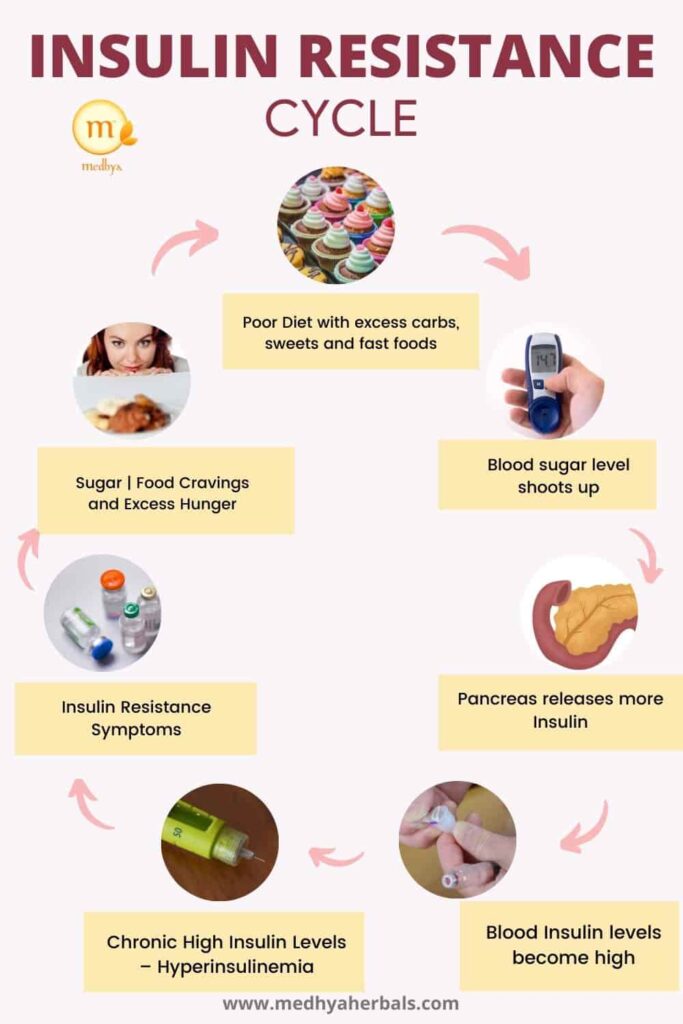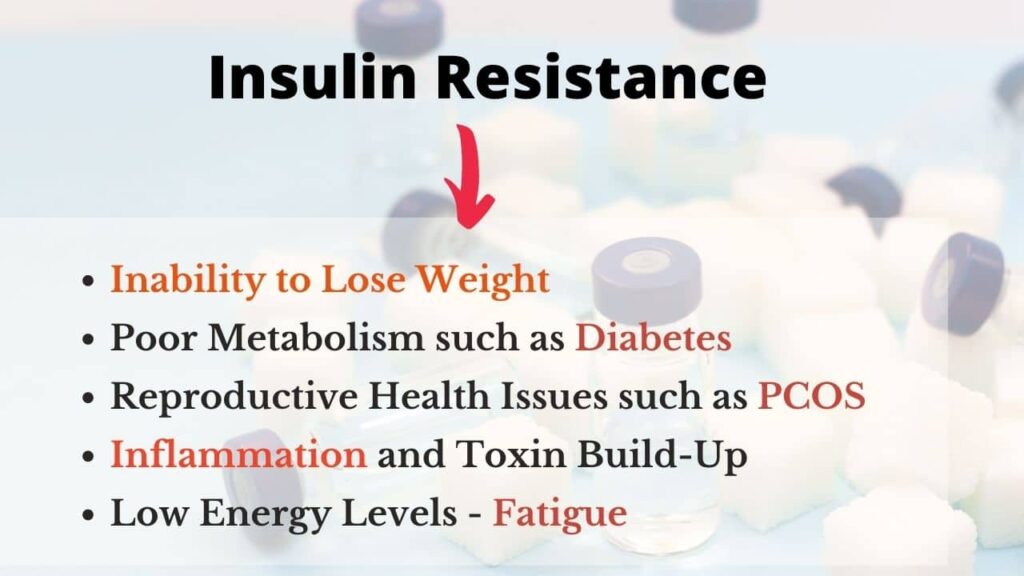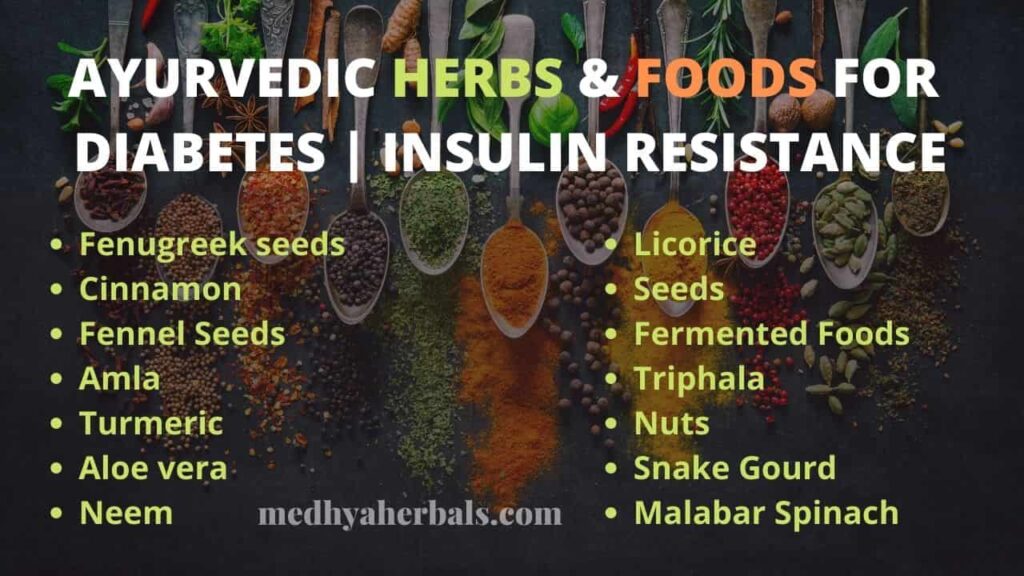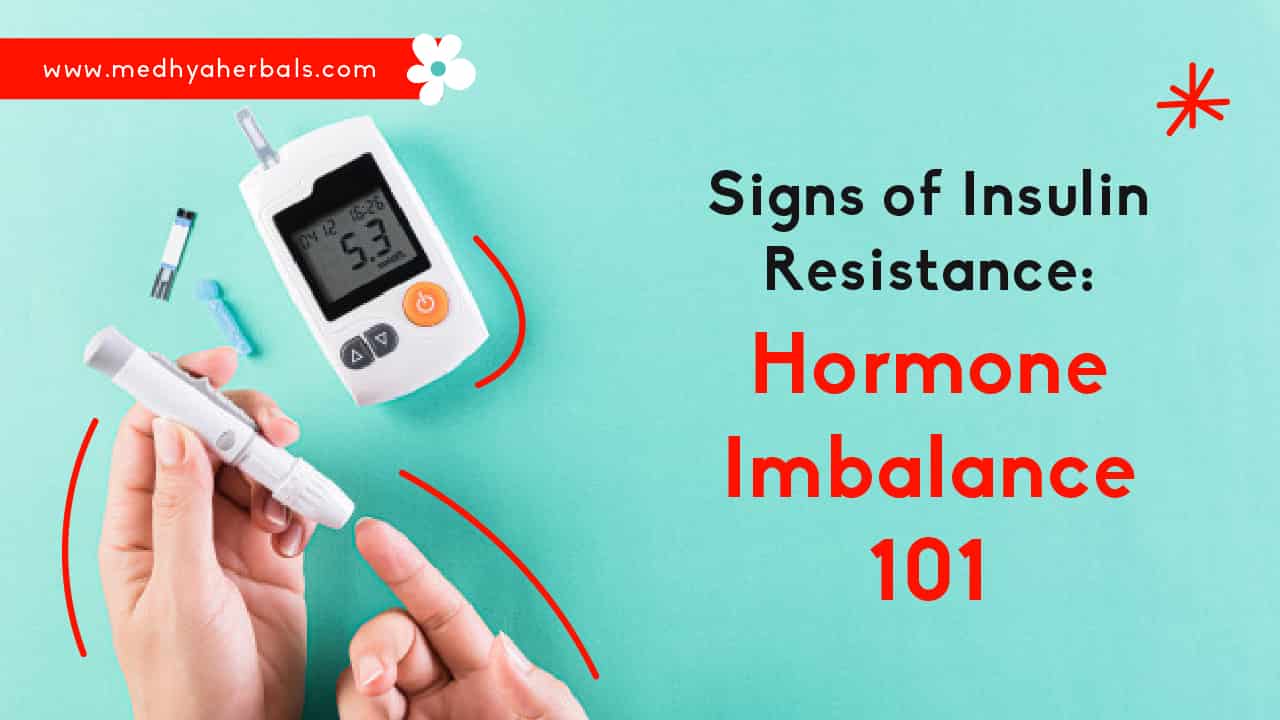Ayurveda considers that Insulin Resistance symptoms arise due to excessive “Ama” or Toxins in the body. When Ama builds up, it creates Kapha Dosha imbalance and disturbs the functioning of Insulin hormone.
Therefore, one should follow a Kapha reducing clean diet and lifestyle to reverse Insulin symptoms.
Insulin resistance is one of THE reasons behind lifestyle disorders such as PCOS, Diabetes, Obesity, and Metabolic Syndrome. It is also one of the most common hormone imbalance health issues that affects men and women alike.
Insuiln Resistance symptoms present with multiple health issues related to poor metabolism, reproductive health issues, inability to lose weight, and inflammation across the body.
Now to understand how you can reverse insulin resistance, you should first look at the whole picture of triggers and causes of insulin resistance.
And once you know the causes, you can make specific changes in diet and lifestyle to reverse insulin resistance symptoms and achieve better health. Let’s get started!

What is Insulin?
Insulin is one of the most important hormones that directs the utilization of food by our body. So, naturally when something is wrong with Insulin, then your body doesn’t know what to do with all that food you are taking in.
It may start to reject all that food and deprive your cells of the fuel they need. Or it may start to store all that food, creating huge chunks of fatty tissues in different parts of your body!
And Insulin does all of this, by controlling glucose or sugar or your body’s primary fuel.
The relationship between Insulin and Blood Glucose (Sugar) Level
Another responsibility of insulin is to make sure that the levels of glucose in your bloodstream are kept at optimal levels.
Glucose is the energy currency of the body. Without sufficient levels of glucose, our cells starve and they start to die. Hence, our body tightly regulates our blood glucose level via Insulin.
Insulin works hand in hand with another hormone known as Glucagon. Both glucagon and insulin are produced in the pancreas.
Insulin helps to reduce blood sugar levels when they get too high. It does this by converting the excess glucose (or sugar) into glycogen. In this format, the energy can be stored for the long-term.
On the other hand, when blood glucose levels fall too low, and there is a demand for energy, glucagon swings into action. It converts the stored glycogen back into glucose, and the body can then utilize it for energy.
That is how it is supposed to be. Unfortunately, things don’t always go as smoothly.
What is Insulin Resistance?
Insulin Resistance or lack of insulin sensitivity is a state in which there is an impaired response to the insulin by our body’s tissues.
Sometimes, the cells of our body resist the action of insulin. That means, when Insulin tells the cells to take in the glucose from the blood, they do not listen. As a result; the levels of glucose in our blood keep rising.
That’s not the end of the story! When our body sees that there is excess glucose in the blood, it begins to wonder, “How come we have all that glucose running around in the blood? Maybe there’s not enough insulin to take care of the situation.”
So, our pancreas produce more insulin to push the excess glucose out of the blood stream and into the cells. But, it doesn’t help! Because, the problem was that the cells are not listening to Insulin.
Hence, pancreas keep producing more Insulin leading to a situation, in which there is excessive insulin in the blood. It is also known as hyperinsulinemia
Initially, the higher the insulin resistance, the more insulin the body produces. Eventually, the resistance is so high that the body can no longer match it up with more insulin. Our pancreas give up and insulin production goes down significantly.

What are the Causes for Insulin Resistance?
As we saw, insulin resistance disturbs the levels of glucose and insulin in the blood stream. And the primary reason behind insulin resistance is that our cells are not listening to Insulin. But, why does it happen? Why do our cells suddenly stop listening?
Maybe there have been too many calls to action?
Let’s check it out!
1. High-calorie diet
Taking a high-calorie diet means that there will be a lot of sugar in your blood all the time. This overworks insulin and the cells of our body.
If care is not taken, this excess sugar may turn out to be too much for the insulin to cope with. So, the insulin levels begin to rise higher and higher.
This could lead to insulin resistance. There will also be hyperinsulinemia, meaning high levels of insulin in your blood.
2. Sedentary lifestyle
Recall that our body’s energy (calorie) currency is glucose (sugar)? When you remain sedentary, you don’t expend enough energy.
And on top of it, if you take in too many simple calories, you end up storing too much energy in your body.
Lack of physical activity and excessive stores of energy lead to Insulin Resistance.
3. Obesity or Excess Body Fat
Being obese can also cause insulin resistance. One possible way this happens is that excess body fat, particularly the one stored in the abdomen (termed as visceral belly fat) can cause the fat cells to choke because they are so packed together.
This leads to the death of the fat cells, and then inflammation. The chain completes by ending in resistance to insulin.
Other causes
- Taking high levels of steroids over a long time
- Excess fat stored in pancreas and liver
- Chronic stress
- High inflammation levels, etc.
What are the Symptoms of Insulin Resistance?

The following symptoms can be observed in a person whose cells are resisting the proper use of insulin:
1. Constant feeling of fatigue
Why will there be fatigue?
It’s quite obvious. The cells of the body are resisting glucose. Imagine if you just refused your salary for a month. What will you spend through that month?
This is what happens with the cells. They resist glucose (the energy currency), so they have no energy.
Additionally, when there is excess glucose, insulin should have converted it into glycogen so that it is stored for when there is a demand for energy.
When you have excess cash in hand, what do you do? You save some of it for the rainy day. What if the bank refused to take the money from you? Maybe you just spend the money on what you don’t really need, or you lose it.
When there is insulin resistance, glycogen can’t be made. So, when there is a demand for energy, there is no energy reserve to draw from.
Hence, insulin resistance births constant fatigue.
2. Increased hunger or thirst
Since there is no energy, you feel hungry. This is not because there is not enough sugar that can be used for energy! But, due to the fact that the sugar is not properly used.
This is poor economics of energy. The result is that you feel like you need to eat more to get some energy.
3. An unusual craving for sweet food
The fastest way to get energy is by taking in lots of sugar. So, when you feel weak and hungry, the brain realizes that you need sugar, so you begin to crave sweet things in order to gain some energy.
4. High levels of glucose in the blood
When all these are combined, hyperglycemia develops. The unused sugar accumulates. This also has its own consequences such as development of Diabetes Type II.
5. Tingling sensation in hands and feet
Insulin resistance also affects the functioning of our neurotransmitters. This can result in problems with our nervous systems. This is known as neuropathy.
In peripheral diabetic neuropathy, there is tingling, burning sensation, and loss of feeling in the hands and toes.
Other symptoms can include skin problems such as fungal infections and a compromised immune system. This can lead to an increased rate of infections in other parts of the body.
6. Others
Some of the other symptoms of insulin resistance include:
- Hard to lose weight
- Hormone imbalance
- High levels of Cortisol hormone and a feeling of being under stress all the time
- High Estrogen
- Low Progesterone levels
- Skin tags and Dark spots on the skin
- Acne breakouts
- Poor Immunity and high inflammation in the body

Health Complications that arise from Insulin Resistance
This condition can lead to further problems and long-term complications if it is not attended to on time. Some of them include:
- Hormone Imbalance
- Polycystic Ovarian Syndrome – PCOS
- Type-II diabetes: The combination of insulin resistance and excessive glucose levels can lead to type-II diabetes and all its attendant problems.
- Obesity and weight gain: One way the body knows to store energy for the long-term is to convert glucose to glycogen. If that doesn’t work, it turns to the other way it knows: fat. Excess sugar becomes stored as fat and this then leads to obesity and weight gain.
- High blood pressure: This, alongside complications with the cardiovascular system as a whole (the heart and blood vessels), also arise.
- Gestational diabetes
- Mental Wellness Issues such as Depression
Can you reverse Insulin Resistance Symptoms?
Yes, you can permanently reverse Insulin resistance symptoms. The key is to make consistent changes in your Diet and Lifestyle such that your body tissues start responding to Insulin. Here’s your 6 Step Plan!
There steps will help you get rid of the toxins in the body that hamper functioning of insulin hormone.
Once you clear the toxins and adopt a balancing diet and lifestyle routine, you are on your path to reverse insulin resistance for good. Let’s get started!
1. Get Active
Exercise helps to burn calories, and so insulin has less work to do. When you exercise, you also lose weight and keep fit and healthy.
Regular physical activity stimulates the response of our body’s cells to insulin’s calling. They become more sensitive. Exercise also stimulates pancreatic production of Insulin. Hence, helping both ways.
It is recommended that you exercise for thirty minutes daily if you can help it. If you can’t do this every day, then exercise for at least four days a week.
2. Improve your Diet
Quit consuming fast food and junk food. These are not help you at all!
Complex carbs are the foods with a low glycemic index. The benefit of eating foods with a low glycemic index is that these foods are broken down slowly and the sugar in them is not released all at once.
Therefore, the insulin is able to keep up with the sugar levels.
However, if you eat food with a high glycemic index, all the sugar is released very fast. You can end up with hyperglycemia.
Examples of low GI food are brown rice, quinoa, vegetables, legumes, etc.

3. Get sufficient Sleep
Poor sleeping habits and sleep deprivation makes insulin resistance worse!
On the other hand, restful sleep with sufficient sleeping hours promotes the sensitivity of Insulin in our body.
4. Manage your Stress Levels
High stress leads to high Cortisol hormone, which decreases insulin sensitivity. Manage your stress by saying no to all activities and people that push stress onto you.
Practice breathing exercises and pranayama to increase your body’s ability to handle stress.
Include adaptogens in your diet. They naturally increases your body’s stress handling capability. Ashwagandha and Shatavari are the best herbs to get started with.
5. Fasting
Fasting has tremendous positive effect on lowering high Insulin levels. Hence, it is highly effective to reverse Insulin Resistance.
Several studies indicate that regulated intermittent fasting improves insulin sensitivity as well as aids in sustained weight loss.
Basically, fasting addresses insulin resistance at its root! It removes the cause, which is persistent high blood glucose levels.
6. Ayurvedic Herbs and Foods to Reverse Insulin Resistance Symptoms
Insulin resistance symptoms can be managed by regular consumption of herbs and foods that stimulate insulin response of the body tissues.
Bitter, Astringent, and Pungent tasting herbs and foods are recommended in Ayurveda to improve insulin sensitivity and also to increase Insulin secretion from the Pancreas.

- Fenugreek seeds
- Cinnamon
- Fennel Seeds
- Amla
- Turmeric
- Aloe vera
- Neem
- Licorice
- Seeds
- Fermented Foods
- Triphala
The symptoms of Insulin Resistance are scary. And the long-term complications of low insulin sensitivity can leave lasting damage to your body.
But, the solution is not too far from your reach! Tend to your insulin resistance as soon as possible by making suitable changes in your diet and lifestyle.
Make your health a priority!
References


Ma’am, my wife is suffering from diabetes. How can I contact you?
Hi Pls send your query at nidhi.bansal@medhyaherbals.com. I’ll get back the soonest. Thanks.
Hello Mam,
Thank you so much for such a beautiful explanation about the Insulin resistance its symptoms and the Ayurvedic cure too.. Really Really appreciate it Mam..🙏🏻🙏🏻🙏🏻
Hello maam, I have diagnosed with pre diabetic, I m 41 yrs and obese. I started all the things recommended. Do I need to take any medicine
Hi! Yes, the first thing you should focus on is improving your diet and lifestyle to start losing the belly fat (weight) immediately. This will help to reverse Insulin Resistance and Prediabetes. At this stage, there isn’t any medication required if your health is good otherwise. However, you should consult your Doctor to confirm. You can also consult with Ayurvedic Doctor Bansal at Medhya Herbals by making an appointment here: https://medhyaherbals.com/ayurvedic-treatment/
Great information.thanque for providing valuable information on insulin resistance